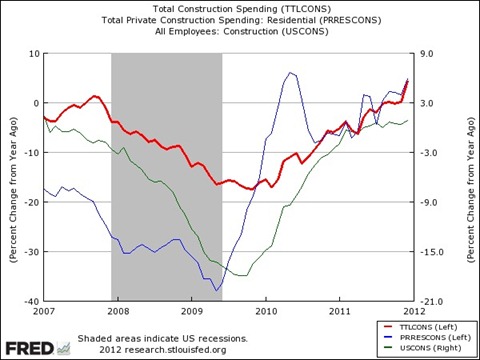click image for larger view and to read the Seattle Time article.
Archives for February 2012
2011 housing market | Seattle Times
When to Buy and When to DIY
 Is this the year of do-it-yourself projects? A new survey suggests it might be.
Is this the year of do-it-yourself projects? A new survey suggests it might be.
According to a JPMorgan Chase poll, “people are taking steps to achieve their goals – and have fun – on their own terms this year.” Here are some of the company’s DIY-related findings:
- 46 percent will exercise at home or outdoors instead of at a gym or health club.
- 59 percent will pamper themselves at home rather than making visits to a spa or salon, which only 22 percent plan to do.
- 29 percent prefer to celebrate a special occasion with a home-cooked meal instead of dining out.
All of these are smart and simple ways to save money at home. Unless you’re just trying to make a superior or unique project, that’s the main goal of DIY work.
Unfortunately, the DIY ethic doesn’t always save money, time, or sanity. If you’ve ever learned the hard way that we have pro services for a reason, here are some factors to consider before tackling another project on your own:
Time.
How valuable is your leisure time? Big projects might require several nights or multiple weekends, and you’ll need to keep tools and supplies somewhere in the meantime. Plus, if you have to dismantle something in the process, it’s out of order until you’re done. This can make long projects or ones in important areas of the house (like the kitchen) pretty inconvenient.
Tools.
Specialized tools can be expensive, and you may not need them again. If you don’t have a friend willing to loan what you need, that means more time and expense in hunting down and buying tools or renting them.
Experience.
How confident are you that your skills are suited to the project at hand? Are there safety risks? Permits required for the work? If you screw up, you have to call a pro anyway – and they may have to fix damage from your mistakes on top of accomplishing the original project. That adds insult to pocketbook injury.
Interest.
If you’re taking on the work as much to learn as to finish a project, then your time will probably be better spent and more enjoyable than a stubborn, grumbling penny-pincher’s. It’s not worth it when the work makes you miserable and leaves you unsatisfied.
Replaceability.
Some things are just cheaper to replace than to fix and most low-end electronics fall into this category. Parts can be hard to find or pricey in comparison. The only time it’s worth spending more on a DIY project than you would to buy it outright is if you get something superior or unique (sentimental value, knowledge, custom-make) out of it.
So what makes a good do-it-yourself project for the average person with no special skills? Here are some scenarios of when to buy and when to DIY:
Food
Buy: Most staples are cheap to buy in bulk – like rice and flour. Some things you should always buy generic. Stock up on the ingredients to your favorite menu items, then learn to make them yourself. Just make sure you know when your food expires so nothing goes to waste or makes you sick.
DIY: If you’ve got the space, start a garden. Seeds are much cheaper, and the food is often much tastier, than store-bought veggies. You can also consider making your own dog food, homemade yogurt, and flavored water.
Cleaning
Buy: Sturdy equipment – cheap mops and sponges end up costing more when you have to replace them often.
DIY: Homemade cleaners are both effective and cost-effective. Learn about the wonders of vinegar and how to make dish soap, laundry detergent, and all-purpose cleaners.
Clothes
Buy: Most things, unless you’re obsessed about quality or took that arts and crafts class seriously. Without practice and knowledge about materials, this is a time-consuming adventure that could be wrecked by the washing machine. Fortunately, there are ways to save on clothing you buy at the store.
DIY: How about Halloween costumes, which only have to last one night? Or custom accessories that won’t hit the wash? Basic mending, sewing, and hemming skills also go a long way to preserving your wardrobe, and a mini-sewing kit doesn’t cost much.
Home repairs and improvements
Buy: This is where things get risky – in terms of time, cost, and safety. When in doubt, use a pro. Jobs for pros: most additions and installations, major electrical work, paving, windows, gutters.
DIY: A lot of energy-efficiency upgrades are simple enough to do yourself and use cheap materials. Most people can handle painting jobs, drywall, and laminate flooring.
“When to Buy and When to DIY” was proved by MoneyTalksNews.com.
Distressed Sales Undercut Home Prices in 2011, Study Says
 A report released today says that home prices slid by nearly 5 percent last year, but also indicates that most of the decline was due to distressed sales.
A report released today says that home prices slid by nearly 5 percent last year, but also indicates that most of the decline was due to distressed sales.
CoreLogic’s December Home Price Index found that home prices fell 4.7 percent in 2011 compared with December 2010, marking the fifth consecutive year of the housing slump. But excluding distressed sales, prices only dropped by 0.9 percent in 2011. The discrepancy between the two figures highlights the foreclosure crisis’ obstructive effect on a market recovery
"Until distressed sales in the market recede, we will see continued downward pressure on prices," said Mark Fleming, chief economist of CoreLogic.
Since the housing bust battered the real estate market in 2007, 8.9 million homes succumbed to foreclosure, according to RealtyTrac
And millions more may share this fate. One expert estimated that, in addition to the 2 million homes already stuck in some state of foreclosure, 1.8 million more will join their ranks in both 2012 and 2013, The Huffington Post reports.
Foreclosure filings dropped dramatically last year, a market movement that would seem to indicate the beginning of a turnaround. But experts say the steep decline was not organic, and instead the result of government crackdowns on banks over alleged foreclosure abuses. The abuses include so-called "robo-signing," a practice where bank employees sign foreclosure documents without adequately reviewing them.
In 2011, distressed sales grew the most in Montana, Vermont, South Dakota, Nebraska and New York, according to the CoreLogic study. It also found that Nevada, Arizona, Florida, Michigan and California are the states that have seen the largest decline in home prices since the peak of the housing boom.
Nevada’s home prices have plunged 60 percent since the peak of the housing market, the report says.
If you are interested in knowing more about the foreclosure process and how to invest in real estate, call me 206-713-3244 or email me.
Fannie Mae and Freddie Mac, Who They Are
 Fannie Mae and Freddie Mac are publicly traded companies that guarantee the majority of new mortgages in the U.S. They are key players in the government’s foreclosure-prevention initiative.
Fannie Mae and Freddie Mac are publicly traded companies that guarantee the majority of new mortgages in the U.S. They are key players in the government’s foreclosure-prevention initiative.
Fannie Mae, officially the Federal National Mortgage Association, and Freddie Mac, the Federal Home Loan Mortgage Corp., were taken over by the government in 2008 after billions of dollars in losses and years of mismanagement.
Fannie and Freddie operate in the secondary mortgage market. They don’t sell mortgages directly to homeowners; they buy mortgages from banks and other lenders, which can use the money to issue new home mortgages.
To increase access to home loans, Fannie was created as a federal agency in 1938 and chartered by Congress in 1968, followed by Freddie in 1970. But they also are publicly traded corporations and — before their taxpayer bailout — had a duty to maximize shareholder return.
Those divergent missions were criticized as a "fundamentally flawed" business model by the Financial Crisis Inquiry Commission, which Congress created to examine the causes of the economic crisis that began in 2007.
Fannie and Freddie loosened underwriting standards leading up to the financial crisis, buying and guaranteeing riskier loans and ramping up purchases of mortgage-backed securities to please Wall Street analysts and to "ensure generous compensation for their executives and employees," the commission determined.
By 2007, the commission said, the companies had $5 trillion in mortgages resting on razor-thin capital.
The commission found that the companies used their political power for decades to  ward off effective regulation and oversight, spending $164 million on lobbying from 1999 through 2008. It concluded, however, that although Fannie and Freddie contributed to the financial crisis, they were not the primary cause.
ward off effective regulation and oversight, spending $164 million on lobbying from 1999 through 2008. It concluded, however, that although Fannie and Freddie contributed to the financial crisis, they were not the primary cause.
With the housing market in turmoil in 2007 and 2008, Fannie and Freddie reported billions of dollars in losses. They were placed in conservatorship under the Federal Housing Finance Agency (FHFA) in September 2008.
Since then, the Treasury Department has provided $169 billion to cover their losses (with repayments the net cost to taxpayers is $141 billion). The total could rise to $363 billion, the FHFA said. Other estimates put the total closer to $390 billion.
Fannie and Freddie’s future is unclear. The Obama administration and Republicans in Congress agree that Fannie and Freddie should be abolished. Last February, President Obama proposed gradually phasing them out and gave Congress options for shrinking the government’s role in housing finance.
The World's Ugliest Music
Something John Cage would’ve appreciated—a pianist performs "the world’s ugliest music," which happens to be the world’s perfect submarine ping.
To see how that works—it has to do with mathematics, repetition, and what brains perceive as beautiful—check it out:
There Was Some Awesome Jobs News Today
Forget the meh ADP report.
The best jobs news of the day was that stronger-than-expected construction number and a particularly strong residential construction number for December.
As the chart above makes clear, growth in residential construction leads construction jobs, so this seems like a pretty sure driver of more construction jobs on the way in the coming months.
Red: Construction spending growth. Blue: Residential construction spending growth. Green: Construction employment growth.
Spectacular Russian Opera and Ballet Theater

Novosibirsk State Academic Opera and Ballet Theatre is the largest and one of the most technically advanced theaters in Russia.
Its main floor features ticket offices and vestibule; on the second floor and the third floor there is a concert hall with adjoining ‘wings’ featuring rehearsal halls, administrative rooms, wardrobes and theater set departments.
The vestibule.

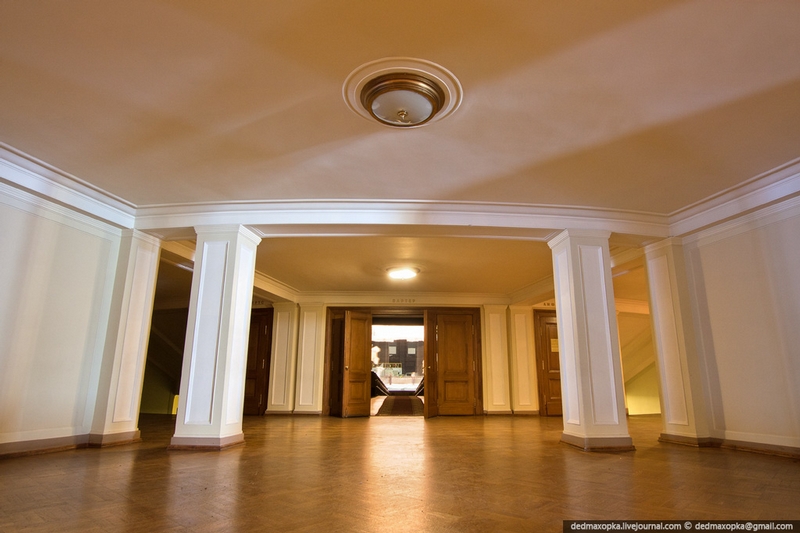
It was completed in February 1944, the first performance being held on May 12th, 1945. During these years, over 340 opera and ballet performances have been held here. Today, over 800 people work in the theater and about half of them are performers.
Construction works lasted for about 10 years, from 1931 till 1941. Some say that is was built by Germans but it’s not true. During WWII, a lot of exhibits from museums located in the European part of the USSR were kept here, including the Hermitage, Tretyakov Gallery and Bolshoi Theater.
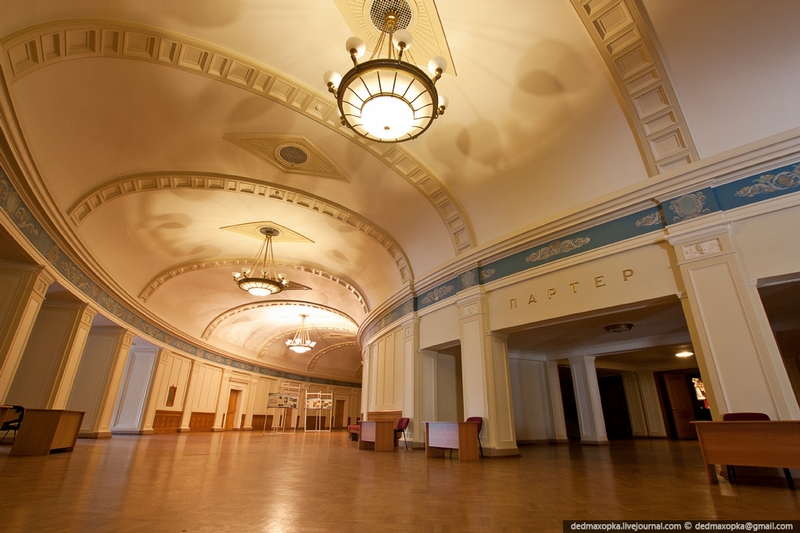
The total area of the building is 11,837 m², the volume is 294,340 m³. The theatre is often called “Siberian Coliseum” for its size and beauty.
They spent over 33 million dollars on its renovation which ended in 2005. After that, its computerized stage equipment became the most technically advanced in Russia.

The concert hall.
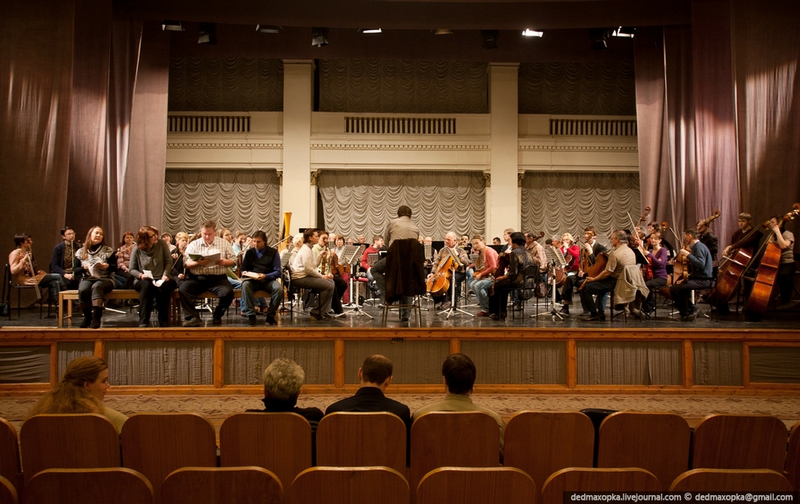

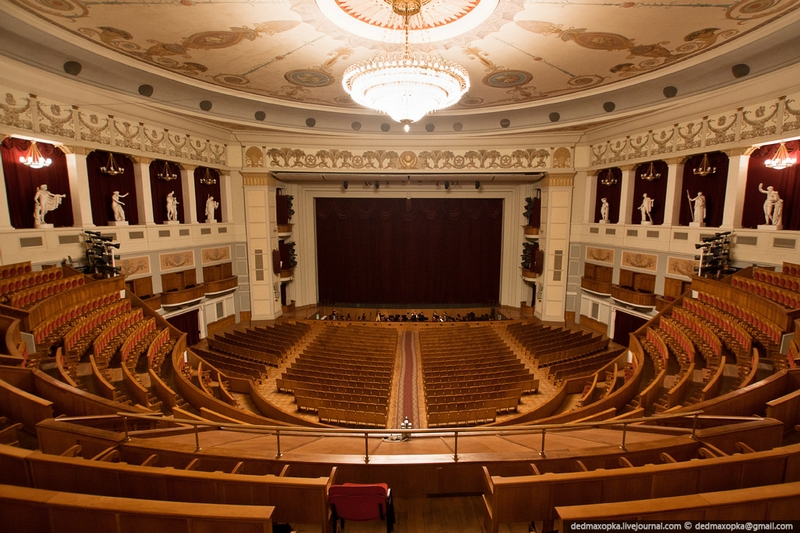
The grand hall.
After the reconstruction, they increased the number of seats in the grand hall to 1,774.
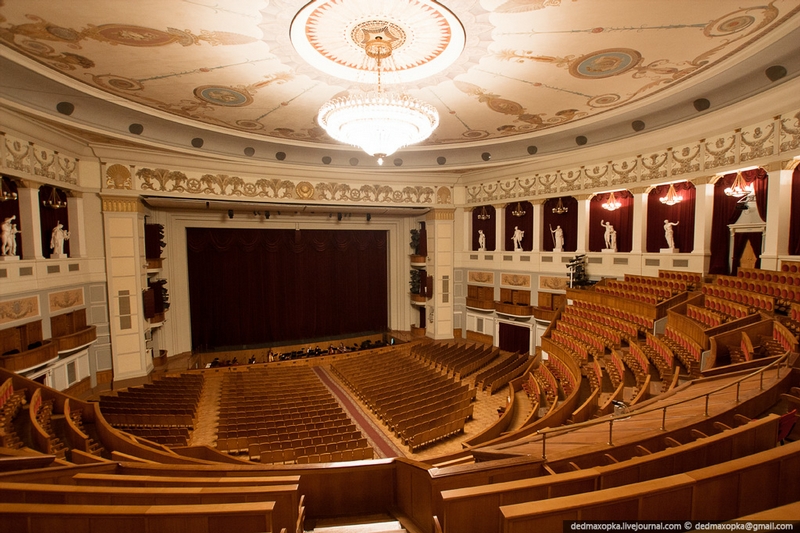
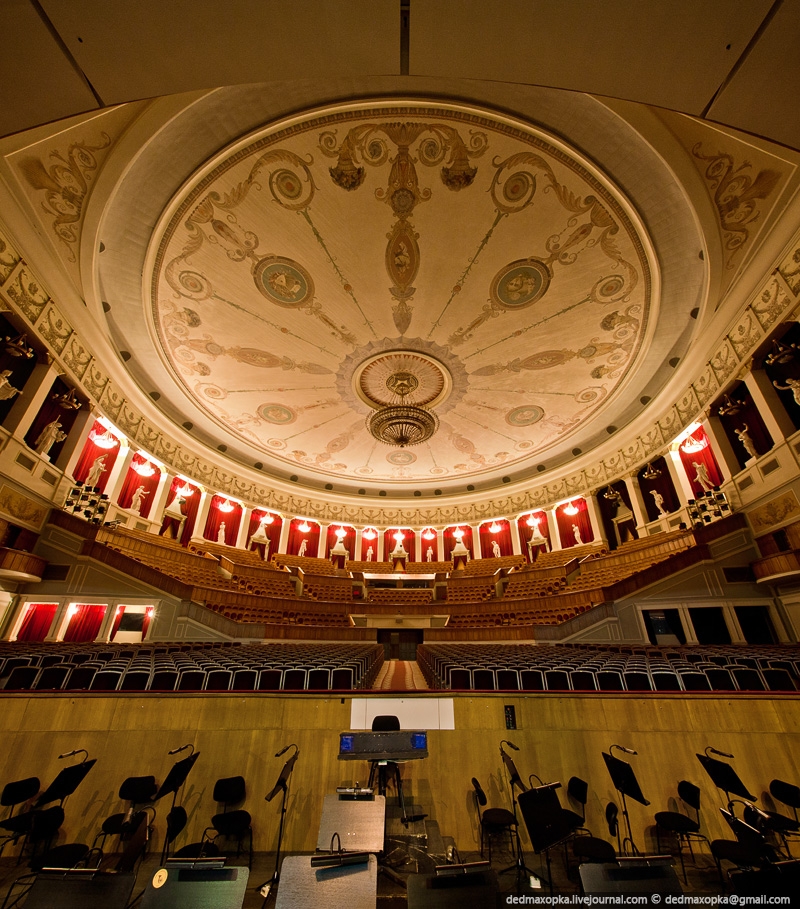

The filled the space between the columns of the upper gallery with 16 sculptures.
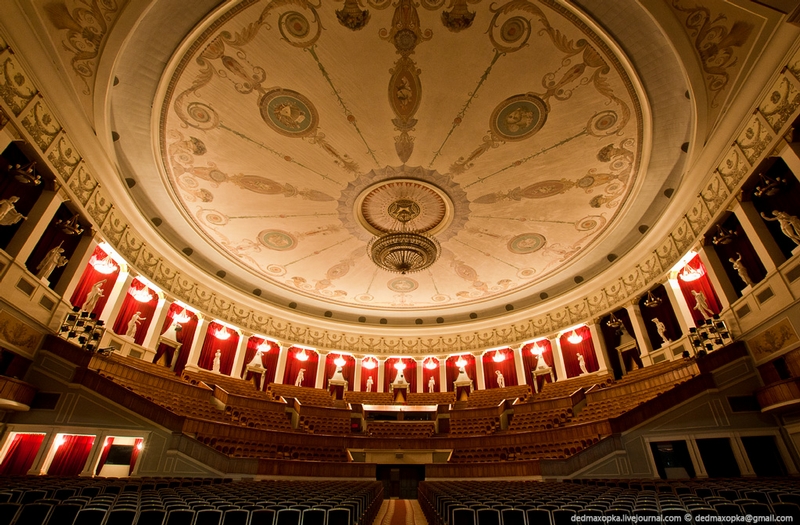
The ceiling of the grand hall is a kind of the acoustic screen made of pressed carton.

The chandelier is 6 meters in diameter and has a weight of over 2 tons.
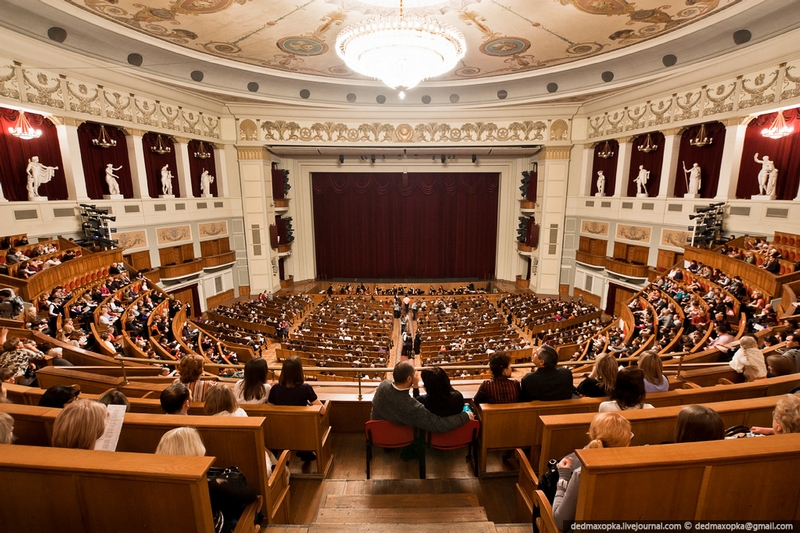
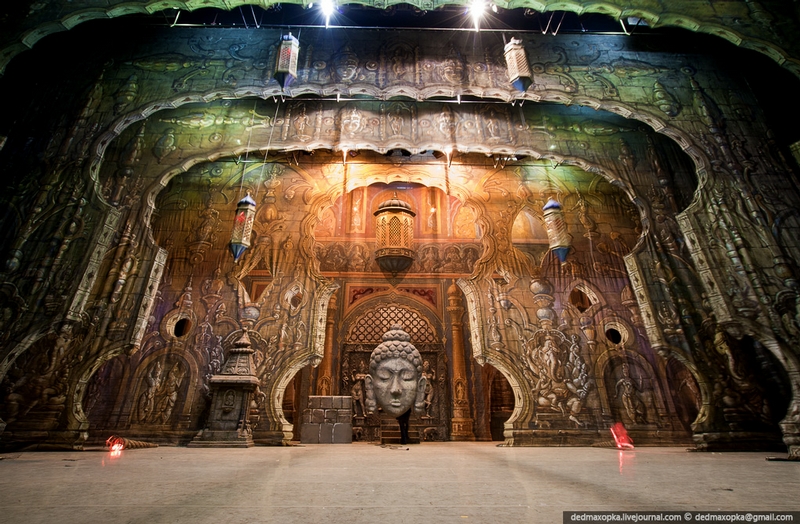
This is a theater set for La Bayadère.
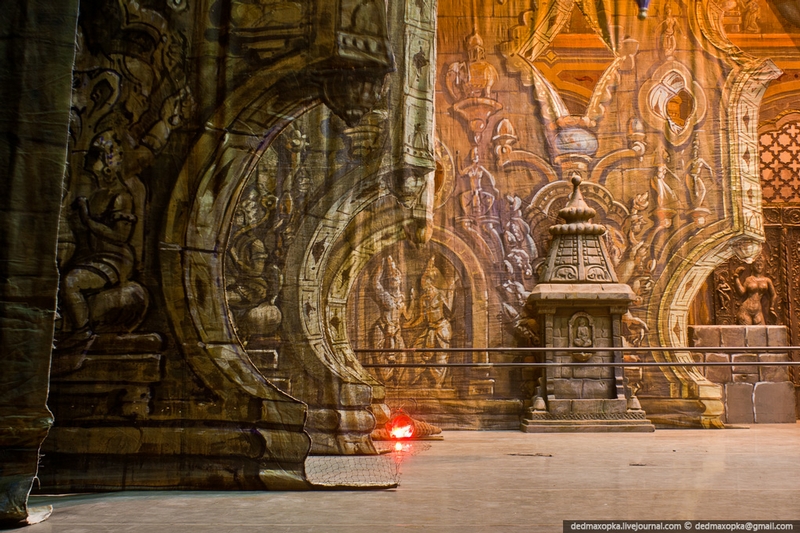
The view from the roof of the theater.

Compare it with this photo which was taken a year ago.

The principal construction of Novosibisk theatre’s building is the big dome, 60 metres wide and 35 metres high. The dome is a unique construction that supports itself without girders or columns. The ratio of its thickness (an average of 8 cm) to its radius is less than that of a chicken egg.


This photograph was taken from the top of a neighboring building.
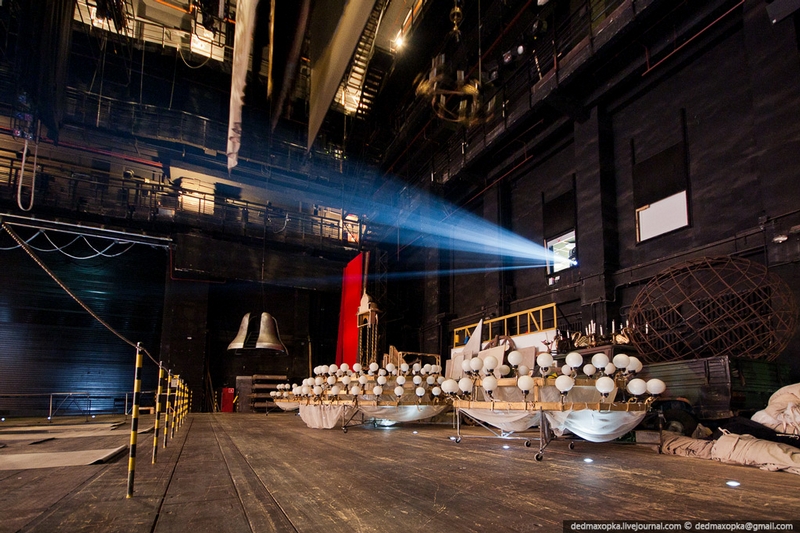
Now, let’s check what happens backstage.
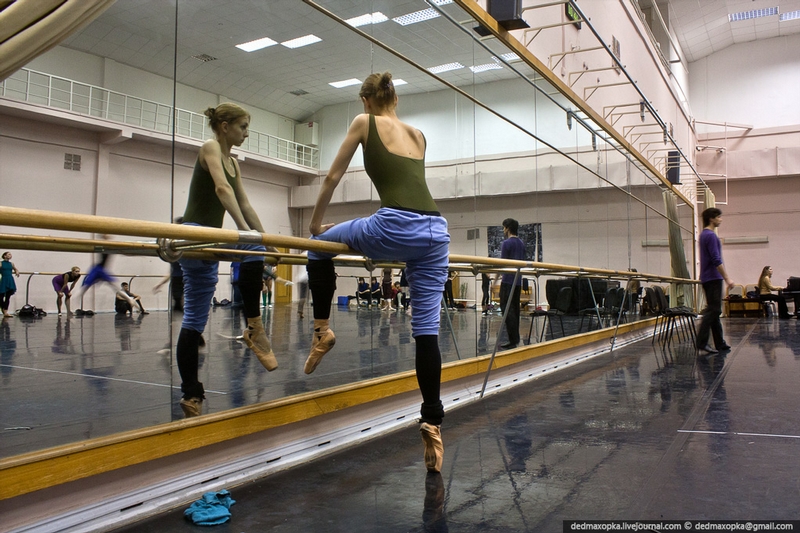
This is a large rehearsal hall for ballet dancers (there is also a small rehearsal hall in the theater).
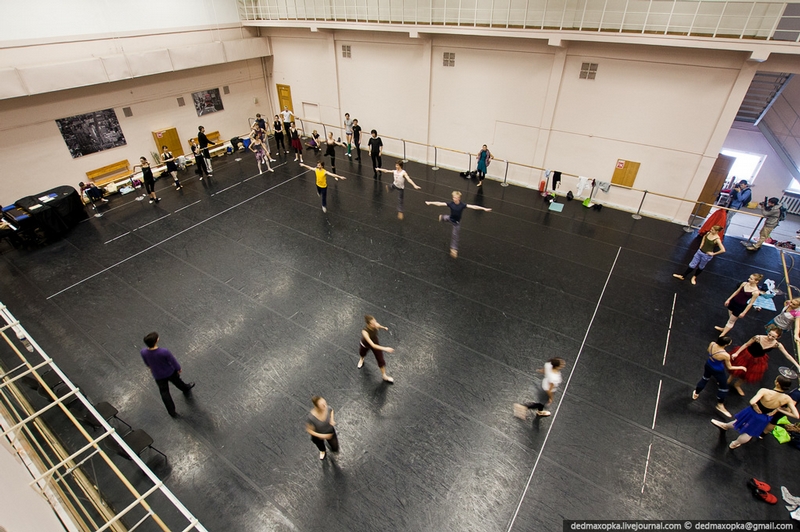

Assembling the theater set for La Bayadère.
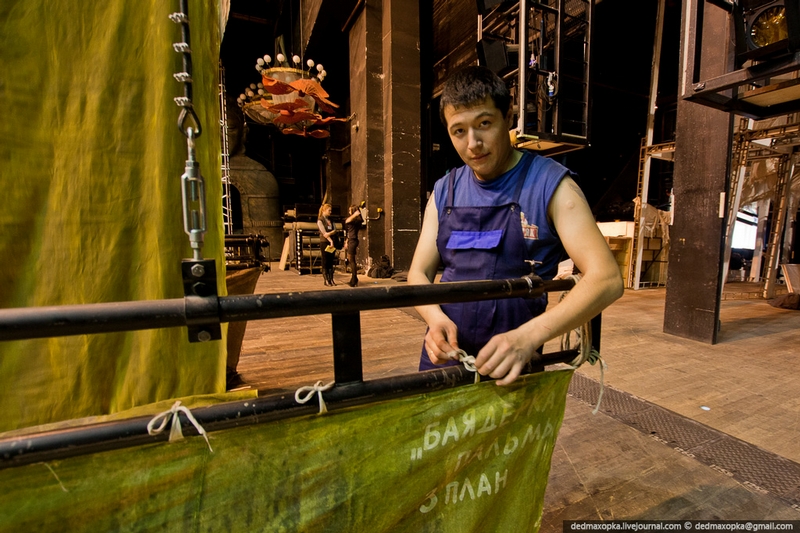
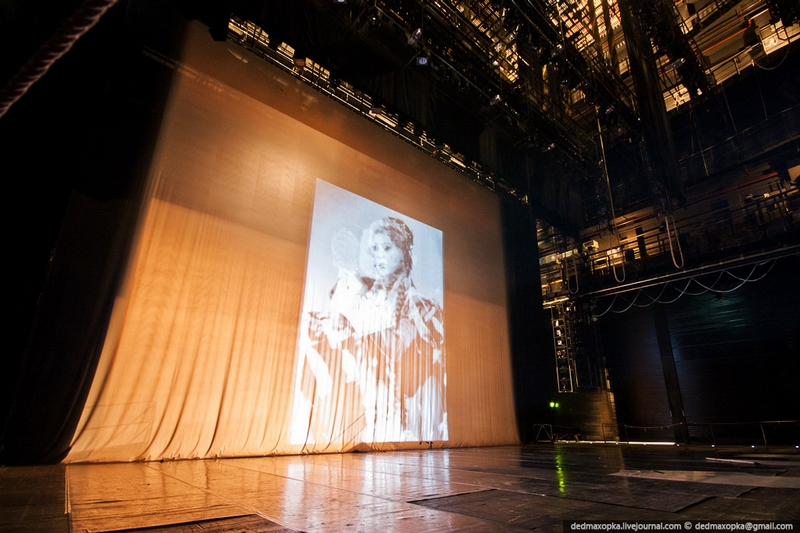
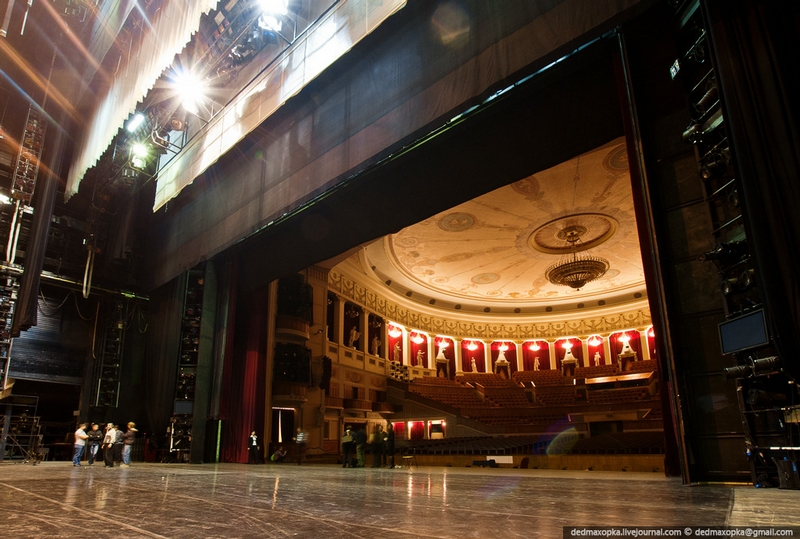
This stage is one of the largest in Eurasia.
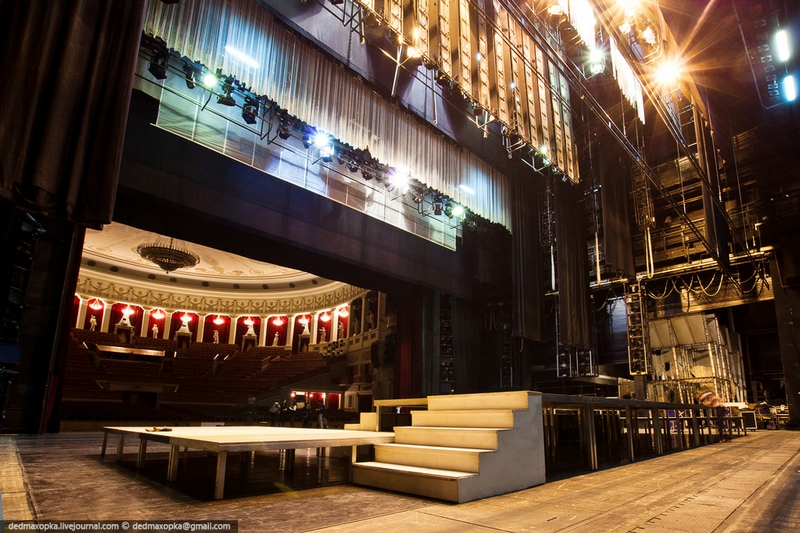
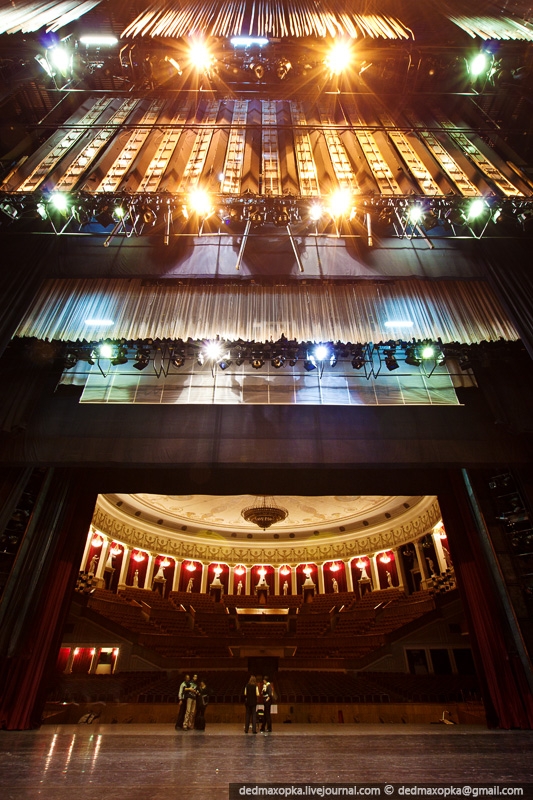
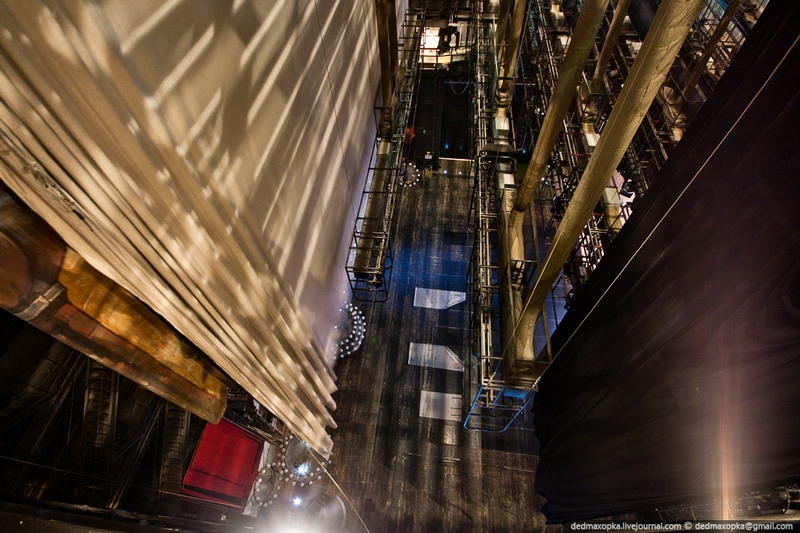
We’ve got this high (27 meters above the ground) to see how this setting is fixed.
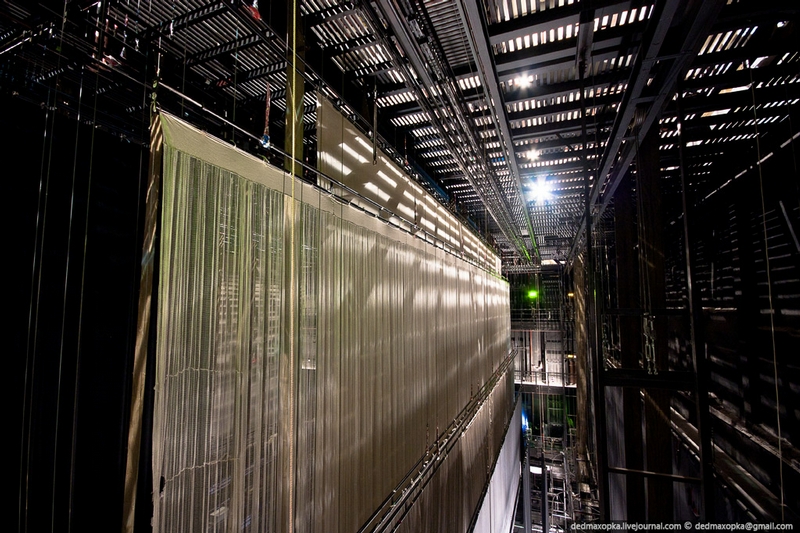

These electric motors are used to pull the setting up and down.
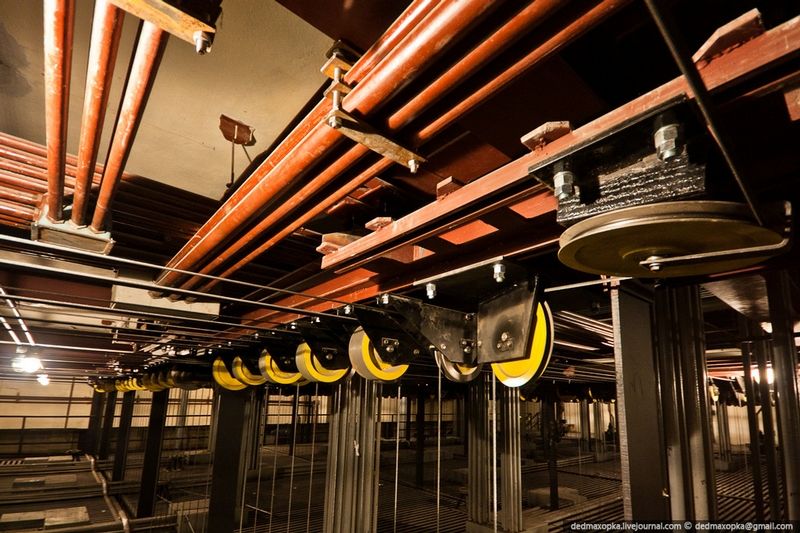
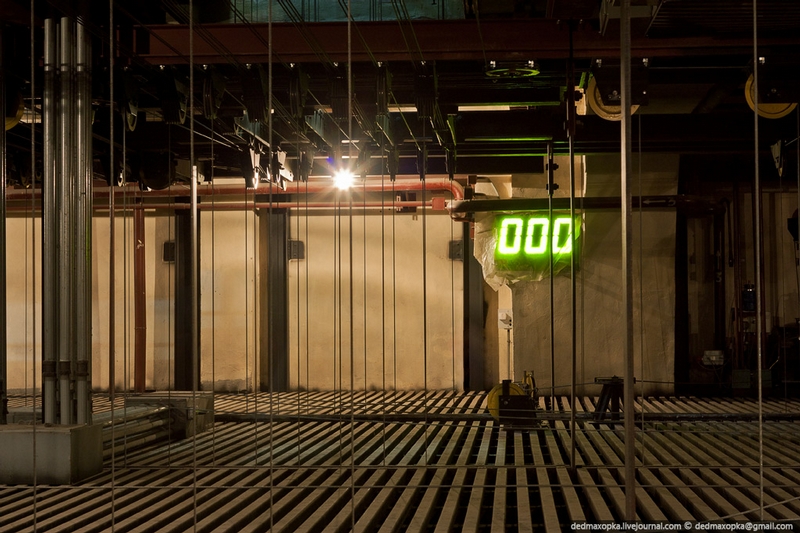
With this clock they synchronize the process of raising and lowering the theater setting.

Lift devices.

They control the setting from one of the balconies above the stage.
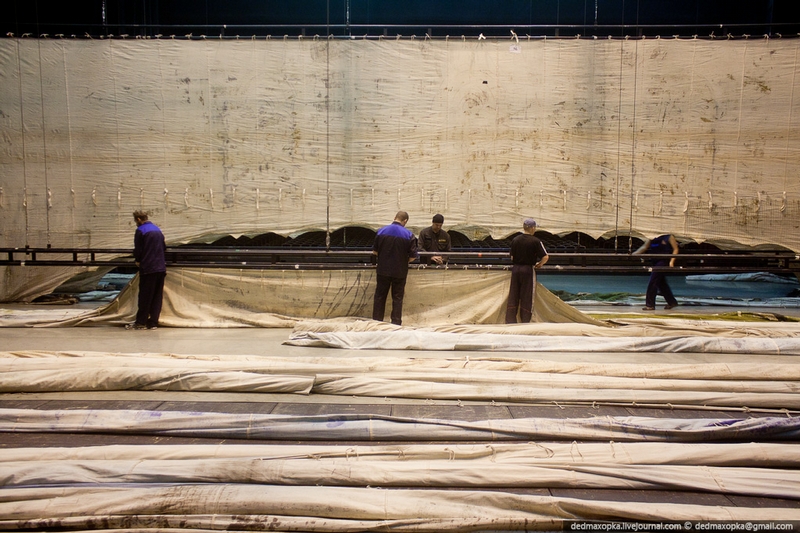

The orchestra pit.

Right now, they are carrying out a sound check.
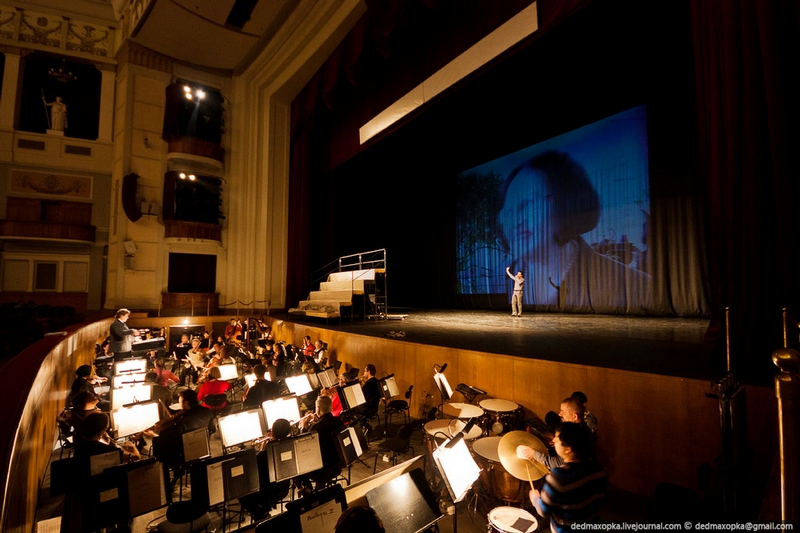
Karen Movsesyan is an opera singer and head of the theater’s PR department.
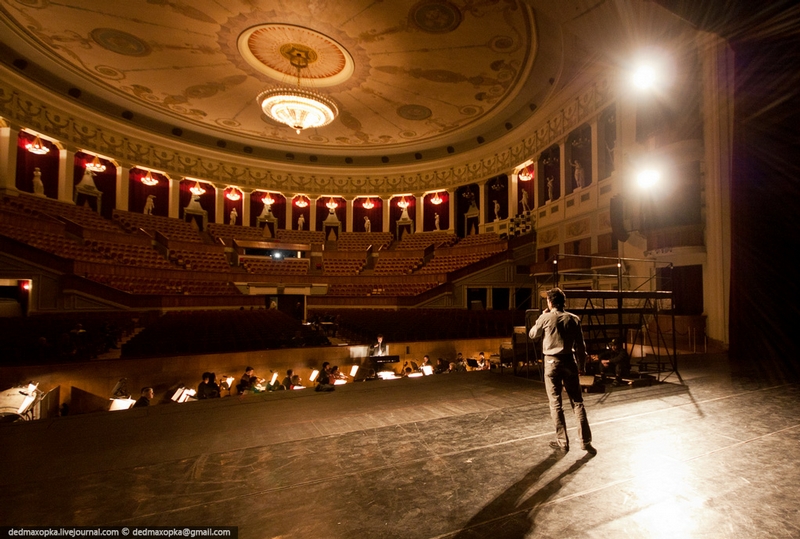
Behind the stage, they keep hard setting elements.
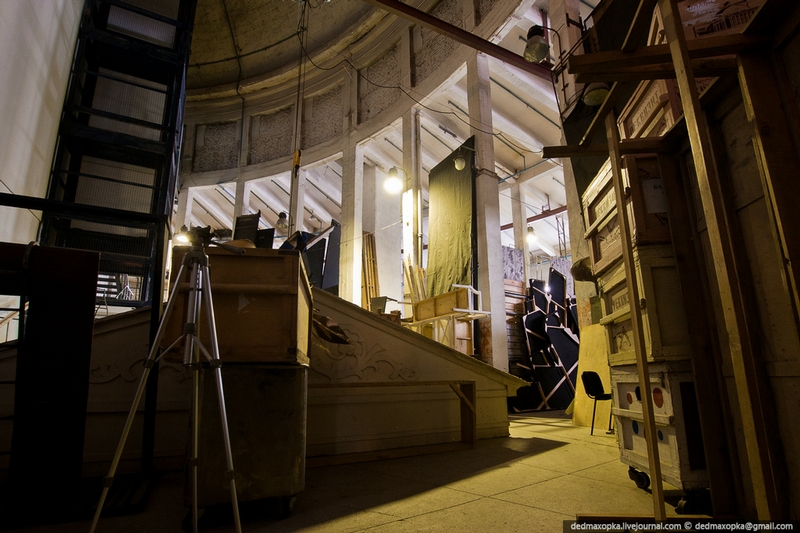
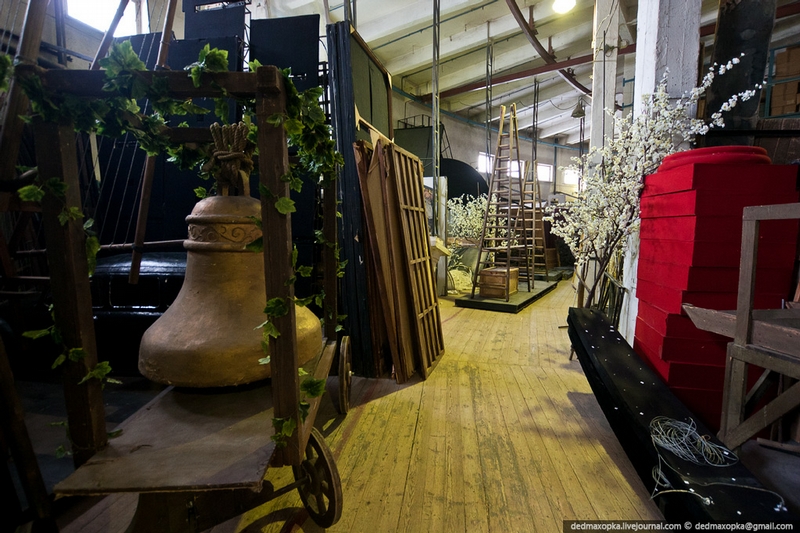


Here, they make costumes.

Each costume is made individually for each actor or ballet dancer.
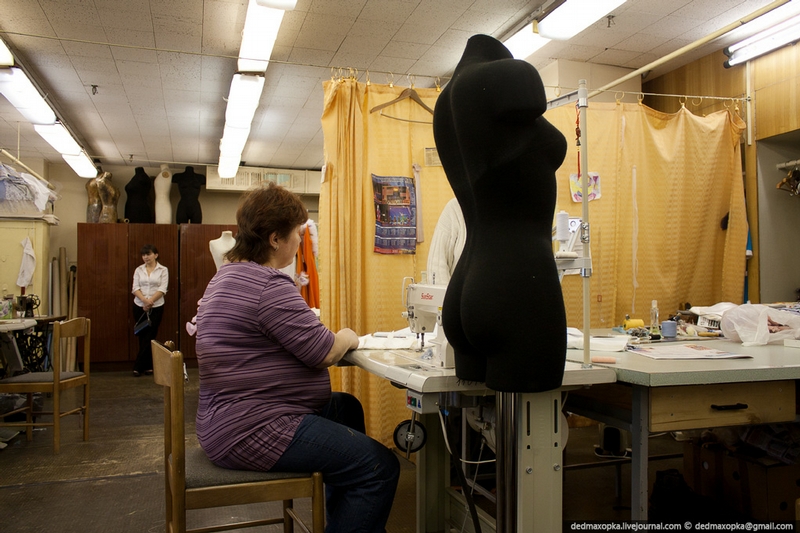

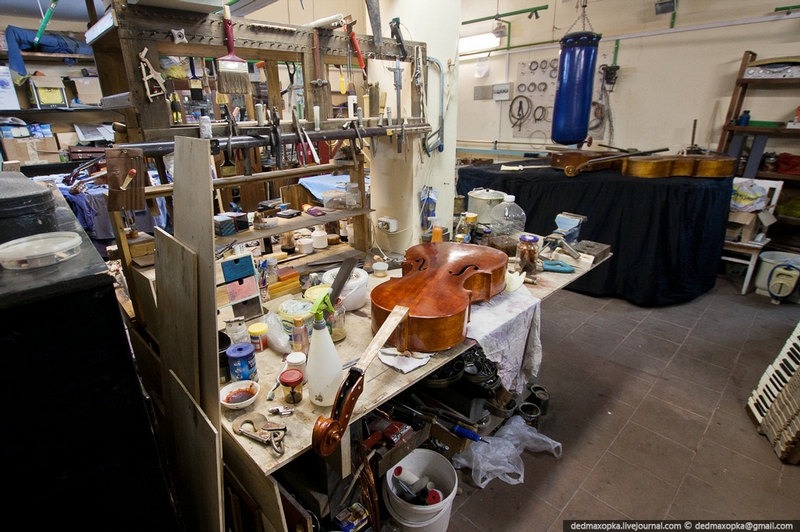
Here they repair musical instruments.
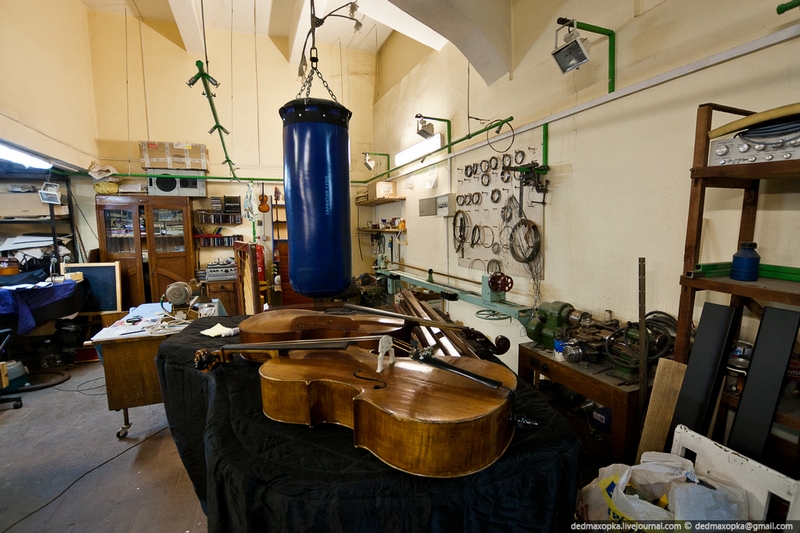
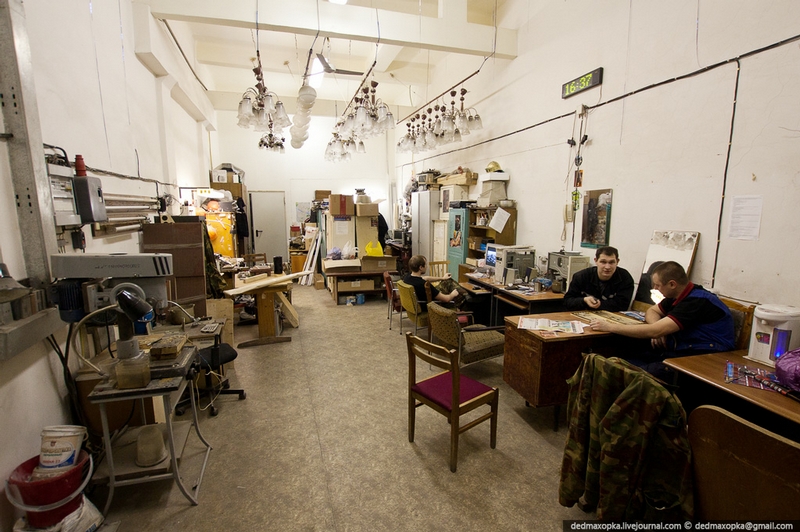

Before another play. They always play to a full house!


Location: Novosibirsk

